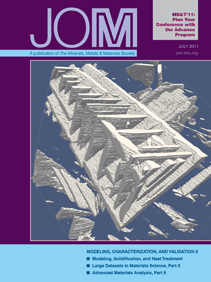VISIT THE
JOM COVER GALLERY
|
|
Understanding U.S. Patent File Histories
David V. Radack In order to obtain a patent for an invention,
the inventor (usually with the assistance of a patent attorney) files
a patent application with the patent office. In the United States,
the inventor files the patent application in the United
States Patent and Trademark Office (USPTO). The patent application
is assigned, usually on a first-come, firstserved basis, to a patent
examiner who has education, training, and/or experience in the technical
field to which the invention is related. Patent examiners, typically,
are scientists or engineers by training, and, it may be surprising
to some, most patent examiners are not lawyers.
The patent examination process is sometimes called “prosecution.”
During prosecution, the patent examiner will examine the patent application
to determine if the requirements for obtaining a patent are met. Broadly
speaking, the patent examiner focuses on two general requirements:
whether the invention is adequately described, through written text
and/or drawings, so that the invention can be understood and practiced
by others once the patent expires, and whether the claimed invention
meets the statutory requirements of utility, novelty, and unobviousness
in light of the “prior art.” In the United States, the
prior art includes prior patents (whether issued in the United States
or abroad) and publications made anywhere in the world.
To determine this last requirement, the patent examiner will perform
a search of the prior art. The USPTO
has voluminous amounts of prior patents and publications classified
by subject matter, many of which are available on computer databases.
The patent examiner will search the prior art relevant to the invention
to determine whether the invention claimed in the patent application
is novel and unobvious.
The end product of the patent examiner’s initial examination
and search of the prior art is a document called an “office
action.” In this document, the patent examiner can raise objections
to the textual content of the patent application and/or rejections
of the claims based on the prior art search. This office action is
forwarded to the inventor and to his or her patent attorney. The inventor
then has the opportunity to respond to the patent examiner’s
office action. The patent examiner, after receiving the inventor’s
response, can either issue a further office action or can allow (i.e.,
approve) the patent application. This communication between the inventor
and the patent examiner is commonly referred to as the prosecution
history of the patent application. This prosecution history is memorialized
in the various writings, thus creating at the USPTO
the so-called file history of the patent application.
The file history becomes extremely important and very relevant if
a charge of infringement of a U.S. patent is made. In such a case,
the alleged infringer will generally order the file history of the
U.S. patent unless a review of the patent leads to a clear conclusion
that there is no infringement. This is because under U.S. law, one
of the steps in determining infringement is to ascertain the scope
of the claims of the patent. The scope of the claims of the patent
is determined by first looking at the claims, then the description
of the invention in the patent application, and then finally at the
file history. For example, statements made during prosecution by the
inventor can help define or narrow a term in the claims. These statements
may be used to interpret an ambiguous or unclear word or phrase in
the claims.
Furthermore, the applicant’s statements in the file history
as to the content and scope of the prior art can be very helpful in
interpreting the scope of the claims alleged to be infringed. Also,
amendments can be made to the claims of the patent application. For
example, the inventor, in response to a rejection by the patent examiner,
may have narrowed his claims by amendment. Under the doctrine of “file
wrapper estoppel” (sometimes also called prosecution history
estoppel), a patentee cannot recapture lost claim scope that the patentee
gave up in order to obtain allowance of the claim. The only way to
determine this is by reviewing the file history.
Other events and statements in the prosecution history can be very
helpful in determining the scope of the claims. One of many examples
can be the written statement made by the patent examiner after a personal
or telephone interview with him or her by the inventor and/or the
patent attorney. These statements can provide a unique insight into
the patent examiner’s thinking about the application. Another
example, which is less frequently encountered, is a written statement
of the examiner’s “reasons for allowance” of the
claims. This statement, if made, can also provide invaluable assistance
in determining the scope of the claims.
David V. Radack is vice chair of the Intellectual Property Department
and a member of Eckert Seamans Cherin & Mellott, LLC in Pittsburgh,
Pennsylvania.
For more information, contact A.B. Silverman at Eckert
Seamans Cherin & Mellott, LLC, 600 Grant Street, 44th Floor, Pittsburgh,
Pennsylvania 15219; (412) 566-2077; fax (412) 566-6099; e-mail abs@escm.com.
|

